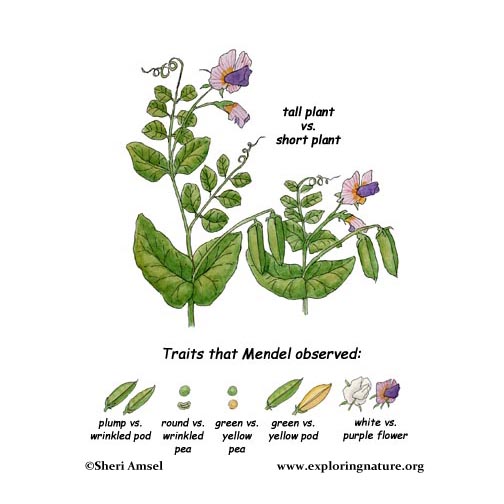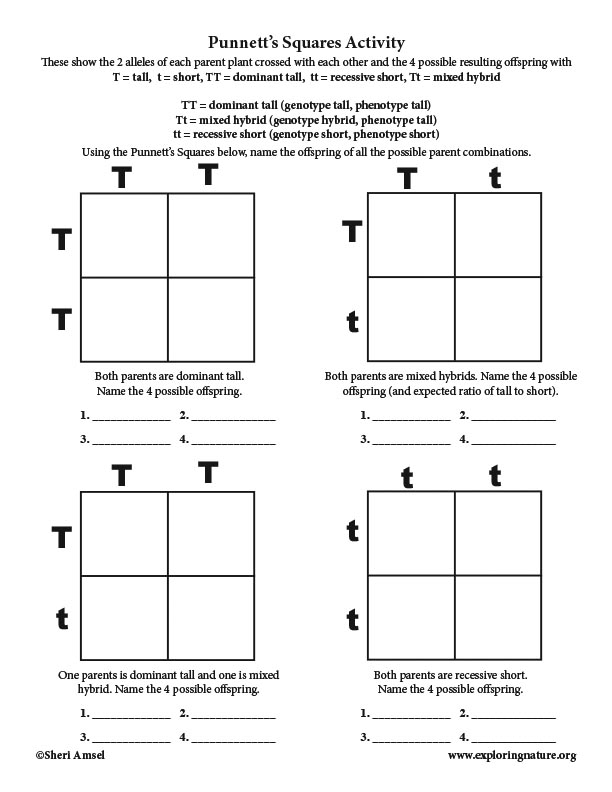

Gregor Mendel, was a monk in Austria in the mid-1800s who raised peas in the monastery gardens. While breeding his peas, he made some big discoveries. They were discoveries about genetics.
The peas had several traits he could see. Some plants were tall and some were short. Some had wrinkled pods and some had smooth pods. Some pods were green and some where yellow. The flowers were white or purple. Mendel looked at each trait and learned how they were passed down to the offspring plants. Since plants breed using pollen, Mendel controlled which plants pollinated other plants. This was how he discovered many important genetic rules.
How an individual looks and what their genetic code is sometimes do not match up. This is the difference between genotype and phenotype. The genotype is the actual genetic make up of an individual. The phenotype is what that individual looks like.
Traits that show up more often are called dominant traits. Traits that show up less often are called recessive traits. If an individual with dominant traits breeds with an individual with recessive traits, this can result in a hybrid offspring. Hybrid individuals can look like they have dominant traits (phenotype), but actually be hybrid (genotype).
Hybrid plants are different from dominant plants even if they looked the same. Each gene has two chances at a trait – two copies — two alleles. So a hybrid plant could be carrying the allele for a recessive trait even if you can’t see it. So, for example, a hybrid plant might be tall like its dominant parent, but it still could have an allele for shortness that you don’t see. This is the difference between genotype and phenotype. The genotype is the actual genetic make up of an individual. The phenotype is what that individual looks like.
This can be illustrated with a simple chart. It’s called a Punnett’s Square.
Age: 4th-9th grade
Objectives: After this lecture and activity sheet, students will know who Gregor Mendel was, what he discovered about genetics, what traits are, the difference between genotype and phenotype, what dominant traits are, what recessive traits are, what hybrid means, what alleles are, what a Punnett’s Square is, and how to find phenotype and genotype using it.
Procedure: We’ll use the example of tall pea plants verses short pea plants. When two tall dominant plants breed, all the offspring are tall dominant. When two hybrid plants breed, one in four of the offspring are short. This is a 3:1 ratio.
Use the Punnett’s Square Worksheet to map out the genotype of the offspring.What kind of offspring you would get from a dominant and hybrid parent mix and two recessive parents?
LS3.A: Inheritance of Traits
• Genes are located in the chromosomes of cells, with each chromosome pair containing two variants of each of many distinct genes. Each distinct gene chiefly controls the production of specific proteins, which in turn affects the traits of the individual. Changes (mutations) to genes can result in changes to proteins, which can affect the structures and functions of the organism and thereby change traits. (MS-LS3-1)
• Variations of inherited traits between parent and offspring arise from genetic differences that result from the subset of chromosomes (and therefore genes) inherited. (MS-LS3-2)
LS3.B: Variation of Traits
• In sexually reproducing organisms, each parent contributes half of the genes acquired (at random) by the offspring. Individuals have two of each chromosome and hence two alleles of each gene, one acquired from each parent. These versions may be identical or may differ from each other. (MS-LS3-2)
When you research information you must cite the reference. Citing for websites is different from citing from books, magazines and periodicals. The style of citing shown here is from the MLA Style Citations (Modern Language Association).
When citing a WEBSITE the general format is as follows.
Author Last Name, First Name(s). "Title: Subtitle of Part of Web Page, if appropriate." Title: Subtitle: Section of Page if appropriate. Sponsoring/Publishing Agency, If Given. Additional significant descriptive information. Date of Electronic Publication or other Date, such as Last Updated. Day Month Year of access < URL >.
Amsel, Sheri. "Punnett's Square Activity - Shows Mendel's Genetics" Exploring Nature Educational Resource ©2005-2024. December 13, 2024
< http://www.exploringnature.org/db/view/1323 >

